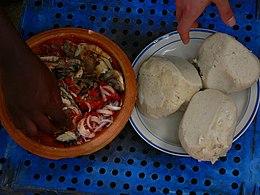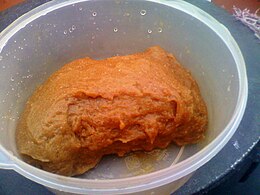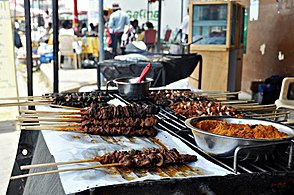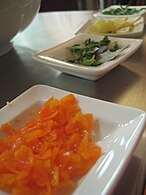Ghanaian cuisine
| Subclass of | African cuisine |
|---|---|
| Culture | culture of Ghana |
| Country | Ghana |
| Country of origin | Ghana |
Ghanaian cuisine dey refer to de meals of de Ghanaian people. De main dishes of Ghana dey center around starchy staple foods, accompany by either sauce anaa soup as well as source of protein. De primary ingredients for de vast majority of soups den stews be tomatoes, hot peppers, den onions. As result of dese main ingredients, most Ghanaian jollof rice, soups, den stews dey appear red anaa orange.
Ghanaian foods dey heavily rely for traditional food crops top dem grow insyd Ghana, dem combine plus crops dem introduce thru colonial den globalized cuisine.[1]
Main staple foods
[edit | edit source]
De typical staple foods insyd de southern part of Ghana dey include cassava den plantain.[2] Insyd de north, de main staple foods dey include millet den sorghum. Yam, maize den beans sanso be staple foods across Ghana. Sweet potatoes den cocoyam sanso be important insyd de Ghanaian diet den cuisine. Plus de advent of globalization, na dem dey increasingly incorporate cereals such as rice den wheat into Ghanaian cuisine notably insyd de form of bread.[3] De foods below dey represent Ghanaian dishes dem make out of dese staple foods.
Foods dem make plus maize
[edit | edit source]- Akple,
- '"BA MI KU" (BANKU)
LEAF insyd Dangme language be "BA" hence de final product earn ein name "BA MI KU" as na dem dey wrap am for leaves insyd wey dem dey shape am into a ball.
- Fanti kenkey dem dey wrap am insyd plantain leaves wey dey give am different texture. Dem dey boil am for long periods into consistent solid balls.[4]
- Banku dem cook am plus cassava den corn dough mixture dem dey bell am agbelimorkple by de Ewe people while de one widout cassava dough mixture dem know am as kutornu-kple (Cotonou banku)[5]
- Mmore be cooked fermented corn dough widout cassava, dem prepare am like banku among de Akan people.
- Kenkey/komi/dokonu be fermented corn dough dem wrap am insyd corn, wey dey originate from de Ga people of de Ga-Adangbe, wey dey bell am komi anaa Ga kenkey. Anoda variety wey dey originate from de Fanti people be Fante dokono, anaa Fanti kenkey, wich dem wrap am plus plantain leaves wey dey give am different texture, flavor, den colour as dem compare to de Ga kenkey. Dem dey boil both for long periods into consistent solid balls.
- Tuo zaafi be millet, sorghum anaa maize dish wey dey originate from Northern Ghana.[4]
- Fonfom be maize dish popular insyd south-western Ghana.[4]
- Abolo, wich dem dey prepare by steaming corn dough den sugar mixture be delicacy among de Ewes. Dem dey chop am plus various soups anaa sauces.
- Yoroyoro be widely eaten across Dagbon den chaw parts of Northern Ghana. Dem dey make am by boiling maize til ebe soften. Dem dey chop de chow plus pepper den onions.
- Nkyekyeraa be Ghanaian dish dem make up of dry corn den few groundnuts, wich be mostly found insyd de Bono, Bono East den Ahafo regions. Dem usually dem wrap am insyd corn leaves anaa fresh leaf wey dem boil am til e cam turn soft enough so say dem fi chew am easily.[6]
Foods dem make plus rice
[edit | edit source]- Waakye— dish of rice den beans plus purple-brown color. De color dey cam from de indigenous grass, Sorghum bicolor.[7]
- Omo Tuo/Rice ball—sticky mashed rice, dem often dey chop am plus groundnut anaa palm nut soup.
- Plain rice—boiled rice wey dey accompany chaw of de variety of red stews.
- Jollof rice
- Fried rice—Chinese-style fried rice dem adapt to Ghanaian tastes.
- Angwa moo—dem sanso dey refer am to as "oiled rice".
Foods dem make plus cassava
[edit | edit source]- Kokonte anaa abete—from dried peeled cassava powder
- Fufu—pounded cassava den plantains; pounded yam den plantain, anaa pounded cocoyam/taro. Dis side dish be always accompany by one of de chaw varieties of Ghanaian soups.
- Gari dem make am from cassava. Dem often serve am plus red red, fish den black-eyed pea stew, anaa shito den fish.
- Attiéké anaa Akyeke—dem make am from cassava wey ebe popular among de Ahanta, Nzema den Akan-speaking people of Ivory Coast.
- Plakali—dem make am from cassava wey ebe popular among de Ahanta, Nzema den Akan-speaking people of Ivory Coast.
- Yakayake, dem make am from steamed grated cassava be favourite among de Ewe people. Dem dey chop am plus various stews anaa soups.
Foods dem make plus beans
[edit | edit source]- Red red den tubaani
- Koose
Foods dem make plus yam
[edit | edit source]
- Ampesie—boiled yam. Dem sanso fi make am plus plantains, cocoyams, potatoes, yams anaa cassava. Dem traditionally dey chop dis side dish plus fish stew wey dey contain tomatoes, oil, den spices.
- Yam fufu—fufu dem make am plus yam instead of cassava, plantains, anaa cocoyam—dem traditionally dey chop am plus Ghanaian soup. Ebe popular insyd Northern den southeastern Ghana.
- Mpotompoto (yam casserole anaa porridge)—slices of yam dem cook plus much water den pepper, onions, tomatoes, salt den preferred seasoning.
- Yam balls - Dis super sweet delicacy dey take de form of scotch eggs, buh insyd dis case, e get de fillings of meat pie, spring rolls, samosa, anaa shawarma.
- Fried Yam - Deep-fried yam fi be served plus variety of stews den pepper sauces. De chips be fried such dat de outsyd be crispy wey de insyd be wet, blissful, den yummy.[8]
- Roasted Yam: dis be one of de most popular street snacks. De white yam plus brown bark be used take make dis dish.[8]
Common Ghanaian dishes
[edit | edit source]-
Banku den grilled tilapia fish
-
Red-red: bean den fish stew plus fried plantain
-
Beans, plantain, den chicken
-
"One Man Thousand": cooked shrimp and fried Tanganyika sardine
-
Ghanaian Kɔkɔ a y'atoto (nickname: Kofi Broke Man) charcoal-roasted ripe plantain
-
Ghanaian Banku Ne Mako (banku den pepper-tomato sauce)
-
Ghanaian style konkonte
-
Ghanaian fufu insyd palmnut soup plus goat meat
-
Fufu den light tomato soup plus meat
-
Fried yam plus spicy chicken den kpakpo shito (ground green peppers)
-
Jollof rice plus coleslaw den barbecue chicken
-
Kenkey plus fried fish den chili pepper
-
Cooked yam den plantain, plus "garden egg" (aubergine) stew den chicken
-
Ghanaian style spicy sauce
-
Ghanaian style spicy grilled kebab
-
Waakye (rice den beans) dem serve plus spaghetti den boiled egg
-
Ground red pepper, Ghanaian delicacy, mainly an accompaniment give banku den kenkey
-
Tubaani
-
Tubaani dem wrap insyd de leaves of Ewe eran
References
[edit | edit source]- ↑ Alpern, Stanley B. (January 1992). "The European Introduction of Crops into West Africa in Precolonial Times". History in Africa. 19: 13–43. doi:10.2307/3171994. ISSN 0361-5413.
- ↑ UNE Applied Nutrition Program (1 July 2019). "Food And Culture In Ghana". All Student-Created Educational Resources.
- ↑ Andah, A. (1982). Breadmaking in Ghana with special reference to composite flours (Report). Council for Scientific and Industrial Research (CSIR),Food Research Institute, Ghana.
- ↑ 4.0 4.1 4.2 "Ghanaian Foods made with maize - Ghfinder". 4 April 2022. Archived from the original on 17 August 2023. Retrieved 17 August 2023.
- ↑ "How To Prepare Banku And Okro Stew In Ghana." My Recipe Joint". My Recipe Joint. Retrieved 25 May 2020.
- ↑ Ali, Biiya Mukusah (1 March 2024). "'Nkyekyeraa' - Most sought after corn meal". Graphic Online. Retrieved 3 March 2024.
- ↑ "Bicolor Sorghum". www.specialtyproduce.com. Retrieved 22 March 2018.
- ↑ 8.0 8.1 "Recipe Wednesday: 8 incredible dishes you can make with yam this Christmas". Prime News Ghana. 8 December 2021. Retrieved 17 August 2023.
Read further
[edit | edit source]- Osseo-Asare, Fran (2018). The Ghana cookbook. Barbara Baeta. New York: Hippocrene Books. ISBN 978-0-7818-1343-3. OCLC 896840053.
- Adjonyoh, Zoe (2021). Zoe's Ghana kitchen. New York: Voracious. ISBN 978-0316335034
External links
[edit | edit source]Ghanaian cuisine at Wikipedia ein sisto projects




















